
Balmoral Cemetery is a cemetery in the Malone area of South Belfast, Northern Ireland, opened in 1855.

Balmoral Cemetery is a cemetery in the Malone area of South Belfast, Northern Ireland, opened in 1855.
The cemetery was opened in 1855 by Presbyterian churchmen Rev. Henry Cooke and Rev. Joseph Mackenzie, on land owned by Mackenzie, after they had been refused burial by a Church of Ireland rector in another cemetery. It was controlled by a board of trustees which included three Presbyterian ministers. While most of the burials were for Presbyterians, other denominations were buried there. [1]
Three Commonwealth soldiers (one each of British, Australian, and Canadian armies) of World War I are buried in the cemetery, their graves maintained by the Commonwealth War Graves Commission. [2]
In 1953, the cemetery was taken over by Belfast Corporation. It is no longer open for burials, but is open to visitors. [1]
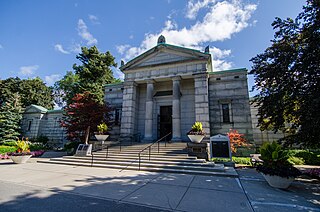
Mount Pleasant Cemetery is a cemetery located in Toronto, Ontario, Canada, and is part of the Mount Pleasant Group of Cemeteries. It was opened in November 1876 and is located north of Moore Park, a neighbourhood of Toronto. The cemetery has kilometres of drives and walking paths interspersed with fountains, statues and botanical gardens, as well as rare and distinct trees. It was originally laid out by German-born landscape architect Henry Adolph Engelhardt, inspired by the European and American garden cemeteries of the 19th century, and with influences from Mount Auburn Cemetery in Boston.

The Dean Cemetery is a historically important Victorian cemetery north of the Dean Village, west of Edinburgh city centre, in Scotland. It lies between Queensferry Road and the Water of Leith, bounded on its east side by Dean Path and on its west by the Dean Gallery. A 20th-century extension lies detached from the main cemetery to the north of Ravelston Terrace. The main cemetery is accessible through the main gate on its east side, through a "grace and favour" access door from the grounds of Dean Gallery and from Ravelston Terrace. The modern extension is only accessible at the junction of Dean Path and Queensferry Road.

Bunhill Fields is a former burial ground in central London, in the London Borough of Islington, just north of the City of London. What remains is about 1.6 hectares in extent and the bulk of the site is a public garden maintained by the City of London Corporation.

Kensal Green Cemetery is a cemetery in the Kensal Green area of Queens Park in the Royal Borough of Kensington and Chelsea in London, England. Inspired by Père Lachaise Cemetery in Paris, it was founded by the barrister George Frederick Carden. The cemetery opened in 1833 and comprises 72 acres (29 ha) of grounds, including two conservation areas, adjoining a canal. The cemetery is home to at least 33 species of bird and other wildlife. This distinctive cemetery has memorials ranging from large mausoleums housing the rich and famous to many distinctive smaller graves and includes special areas dedicated to the very young. It has three chapels and serves all faiths. It is one of the Magnificent Seven cemeteries in London.

Opened in 1852, Mount Royal Cemetery is a 165-acre (67 ha) terraced cemetery on the north slope of Mount Royal in the borough of Outremont in Montreal, Quebec, Canada. Temple Emanu-El Cemetery, a Reform Judaism burial ground, is within the Mount Royal grounds. The burial ground shares the mountain with the much larger adjacent Roman Catholic cemetery, Notre Dame des Neiges Cemetery, and the Shaar Hashomayim Cemetery, an Ashkenazi Jewish cemetery. Mount Royal Cemetery is bordered on the southeast by Mount Royal Park, on the west by Notre-Dame-des-Neiges Cemetery, and on the north by Shaar Hashomayim Cemetery.

Belfast City Cemetery is a large cemetery in west Belfast, Northern Ireland. It lies within the townland of Ballymurphy, between Falls Road and Springfield Road, near Milltown Cemetery. It is maintained by Belfast City Council. Vandalism in the cemetery is widespread.
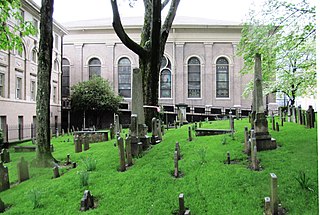
The First Presbyterian Church Graveyard is the oldest graveyard in Knoxville, Tennessee, United States. Established in the 1790s, the graveyard contains the graves of some of Knoxville's most prominent early residents, including territorial governor and Constitutional Convention delegate William Blount and Knoxville founder James White. In 1996, the graveyard was added to the National Register of Historic Places.

Mount Jerome Cemetery & Crematorium is situated in Harold's Cross on the south side of Dublin, Ireland. Since its foundation in 1836, it has witnessed over 300,000 burials. Originally an exclusively Protestant cemetery, Roman Catholics have also been buried there since the 1920s.

Cementerio Británico de Buenos Aires, also known in English as Buenos Aires British cemetery, is a cemetery in Buenos Aires, Argentina. It is in the district of Chacarita in the northern part of Buenos Aires, adjacent to La Chacarita Cemetery.

Henry Cooke (1788–1868) was an Irish Presbyterian minister of the early and mid-nineteenth century.

Greyfriars Kirkyard is the graveyard surrounding Greyfriars Kirk in Edinburgh, Scotland. It is located at the southern edge of the Old Town, adjacent to George Heriot's School. Burials have been taking place since the late 16th century, and a number of notable Edinburgh residents are interred at Greyfriars. The Kirkyard is operated by City of Edinburgh Council in liaison with a charitable trust, which is linked to but separate from the church. The Kirkyard and its monuments are protected as a category A listed building.
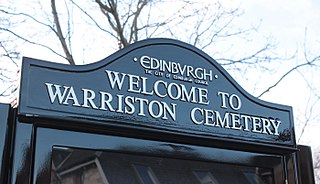
Warriston Cemetery is a cemetery in Edinburgh. It lies in Warriston, one of the northern suburbs of Edinburgh, Scotland. It was built by the then newly-formed Edinburgh Cemetery Company, and occupies around 14 acres (5.7 ha) of land on a slightly sloping site. It contains many tens of thousands of graves, including notable Victorian and Edwardian figures, the most eminent being the physician Sir James Young Simpson.
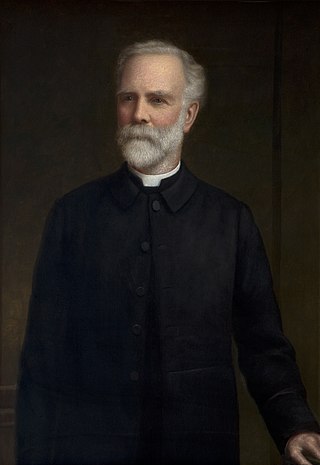
Josias Leslie Porter DD LLD (1823–1889) was an Irish Presbyterian minister, missionary and traveller, who became an academic administrator. He was Moderator of the Irish General Assembly in 1875.

William Dool Killen was a minister of the Presbyterian Church in Ireland and church historian.

The Presbyterian Burying Ground, also known as the Old Presbyterian Burying Ground, was a historic cemetery which existed between 1802 and 1909 in the Georgetown neighborhood of Washington, D.C., in the United States. It was one of the most prominent cemeteries in the city until the 1860s. Burials there tapered significantly after Oak Hill Cemetery was founded nearby in 1848. The Presbyterian Burying Ground closed to new burials in 1887, and about 500 to 700 bodies were disinterred after 1891 when an attempt was made to demolish the cemetery and use the land for housing. The remaining graves fell into extensive disrepair. After a decade of effort, the District of Columbia purchased the cemetery in 1909 and built Volta Park there, leaving nearly 2,000 bodies buried at the site. Occasional human remains and tombstones have been discovered at the park since its construction. A number of figures important in the early history of Georgetown and Washington, D.C., military figures, politicians, merchants, and others were buried at Presbyterian Burying Ground.

New Calton Burial Ground is a burial ground in Edinburgh. It was built as an overspill and functional replacement to Old Calton Burial Ground and lies half a mile to its east on Regent Road in Edinburgh, Scotland, on the south-east slopes of Calton Hill. On its southern edge it attaches to the north-east edge of the Canongate in the Old Town. It lies on a fairly steep south-facing slope with views to Holyrood Palace, the Scottish Parliament Building and Arthur’s Seat.

Morningside Cemetery is a cemetery in south Edinburgh. It was established in 1878 by the Metropolitan Cemetery Company, originally just outwith the then city boundary, the nearest suburb then being Morningside. It extends to just over 13 acres in area. The cemetery contains 80 war graves. Although arguably visually uninspiring the cemetery contains the graves of several important female figures; including a female air commandant, Scotland's first female surgeon, the first female Fellow of the Royal College of Physicians of Edinburgh, a Nobel Prize winner and many church missionaries.

South Rockhampton Cemetery is a heritage-listed cemetery at Upper Dawson Road, Allenstown, Rockhampton Region, Queensland, Australia. It was built from 1860 to 1970. It is also known as Dawson Road Cemetery and Rockhampton Cemetery. It was added to the Queensland Heritage Register on 15 February 1993.

The Old Newton Burial Ground is a historic cemetery located in Newton, Sussex County, New Jersey. The cemetery was the primary burial ground in the town for a century after its establishment in 1762. As the burial ground would reach capacity, the state legislature incorporated the Newton Cemetery Company which began operating a new cemetery in 1867. After this time, interments would continue at the old burial ground intermittently until 1943. The burial ground contains the graves of members of local families from Newton and the surrounding areas, and includes several local and state political figures, prominent citizens, and veterans. While nineteenth-century sources attest 5,000 burials within the cemetery, a recent transcription lists only 1,287 individual known graves.
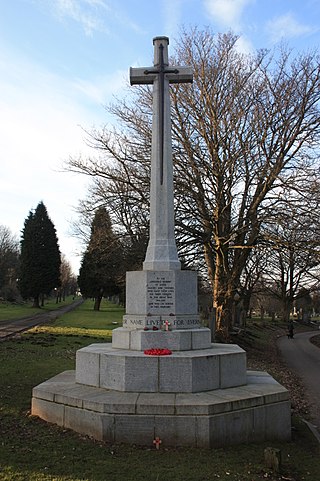
Craigton Cemetery is a cemetery in south-west Glasgow dating from the mid-19th century. It stands on Berryknowes Road.